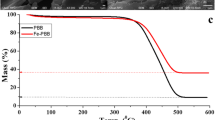Abstract
A pentachlorophenol (PCP)-degrading mixed bacterial population was enriched in a biofilter filled with soft wood bark chips. We found that bark chips were essential for the degradation to proceed at PCP concentrations higher than 10μM. PCP-degrading bacteria were found to be extremely sensitive to PCP. Bark chips absorbed PCP reversibly, thus detoxifying the medium and allowing degradation to proceed at higher concentrations of PCP (beyond 200μM).
Similar content being viewed by others
References
Anonymous (1982) Miljövänlig tillverkning av blekt massa. Final Report of The Association of Swedish Central Association of Cellulose and Paper Industries, 1977-07-01–1981-06-30, prepared by IPK, Stockholm, pp 80–84
Arsenault RD (1976) Pentachlorophenol and contained chlorinated dibenzodioxins in the environment: a study of environmental fate, stability, and significance when used in wood preservation. Proc Am Wood Preserv Assoc: 1–25
Bauchop T, Elsden SR (1960) The growth of microorganisms in relation to their energy supply. J Gen Microbiol 23:457–469
Chu JI, Kirsch EJ (1972) Metabolism of pentachlorophenol by an axenic bacterial culture. Appl Microbiol 23:1033–1035
Dickson D (1980) PCP dioxins found to pose health risks. Nature 283:418
Edgehill RU, Finn RK (1982) Isolation, characterization and growth kinetics of bacteria metabolizing pentachlorophenol. Eur J Appl Biotechnol 16:179–184
Huang JC, Gloyna EF (1967) Effects of toxic organics on photosynthetic reoxygenation. University of Texas, Center for Research in Water Resources, Austin
Izaki K, Takahashi M, Sato Y, Sasagava U, Sato K, Furusaka C (1981) Some properties of pentachlorophenol-resistant gram-negative bacteria. Agric Biol Chem 45:765–767
Kozak VP, Sinsiman GV, Chesters G, Stensby D, Harkin J (1979) Reviews of environmental effects of pollutants. XI. Chlorophenols. United States Environmental Protection Agency, National Technical Information Service, Springfield, Virginia
Liu D, Thomson K, Strachan WMJ (1981) Biodegradation of pentachlorophenol in a simulated aquatic environment. Bull Environ Contam Toxicol 26:85–90
Lu PY, Metcalf RL, Cole LK (1978) The environmental fate of14C-pentachlorophenol in laboratory model ecosystem. In: Ranga RK (ed) Environmental Science Research 12. Pentachlorophenol chemistry, pharmacology and environmental toxicology. Plenum Press, New York and London, pp 53–63
Pierce RH, Victor DM (1978) The fate of pentachlorophenol in an aquatic ecosystem. In: Ranga RK (ed) Environmental Science Research 12. Pentachlorophenol chemistry, pharmacology and environmental toxicology. Plenum Press, New York and London, pp 41–52
Rudling L (1970) Determination of pentachlorophenol in organic tissues and water. Water Res 4:533–537
Salkinoja-Salonen MS, Apajalahti J (1982) Studies on microbial degradation of pentachlorophenol and 2,3,7,8-tetrachlorodibenzo-p-dioxin. U.S. Environmental Protection Agency, IERL Report on project no 68-03-2936, Cincinnati, Ohio
Salkinoja-Salonen M, Saxelin M-L, Jaakkola T, Saarikoski J, Hakulinen R, Koistinen O (1981) Analysis of toxicity and biodegradability of organochlorine compounds released into the environment in bleaching effluents of kraft pulping. In: Keith LH (ed) Advances in the identification and analysis of organic pollutants in water. 2. Ann Arbor Science Publishers/the Butterworth Group, Ann Arbor, pp 1131–1164
Salkinoja-Salonen M, Hakulinen R, Valo R, Apajalahti J (1983) Biodegradation of recalcitrant organochlorine compounds in fixed film reactors. Wat Sci Tech 15:309–319
Scott HD, Wolf DC, Lavy TL (1982) Apparent adsorption and microbial degradation of phenol by soil. J Environ Qual 11:107–112
Sundman V (1964) The ability ofα-conidendrin decomposing Agrobacterium strains to utilize other lignans and lignin-related compounds. J Gen Microbiol 36:185–201
Suzuki T (1977) Metabolism of pentachlorophenol by a soil microbe. J Environ Sci Health B12:113–127
Watanabe I (1973) Isolation of pentachlorophenol decomposing bacteria from soil. Soil Sci Plant Nutr 19:109–116
Author information
Authors and Affiliations
Rights and permissions
About this article
Cite this article
Apajalahti, J.H.A., Salkinoja-Salonen, M.S. Absorption of pentachlorophenol (PCP) by bark chips and its role in microbial PCP degradation. Microb Ecol 10, 359–367 (1984). https://doi.org/10.1007/BF02015560
Issue Date:
DOI: https://doi.org/10.1007/BF02015560




